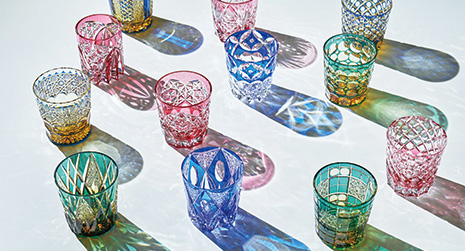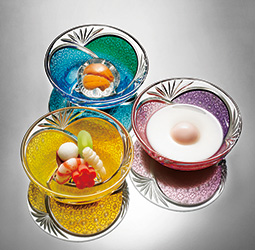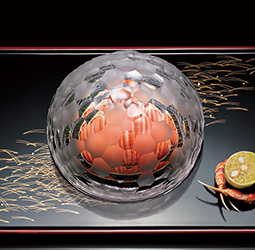INDEX
- English
- 日本語

Edo kiriko glassware cut with some of the popular patterns - English
- 日本語

Patterns are cut into the glass using rotating grindstone tools



New look Edo kiriko glassware
January 2021
Glittering Patterns Engraved on Glass

Edo kiriko is a traditional Tokyo craft. It was born of an admiration for Western cut glass. The shine of Japanese traditional design emerges on the surface of Edo kiriko glassware.

Edo kiriko is a type of cut glass in which patterns are created by etching the surface of the glass. Its origins date back to the late Edo period (1603–1867) when people admired the beauty of glassware brought to Japan from the West and experimented with ways of reproducing it in Japan. The result was a technique called kiriko.
Edo kiriko is said to have first been produced in 1834 by the glass merchant Kagaya Kyube. In 1881, early in the era of national modernization during the Meiji period (1868–1912), the government established Japan’s first Western-style glass factory, inviting an Englishman to take the helm. The techniques introduced at that time are still used today.
Nowadays, the patterns of Edo kiriko are hand-made by pressing the glassware against a high-speed rotating grindstone tool. Many of the patterns originated in the West, but the incorporation of traditional Japanese patterns and designs makes the glassware unique. One example is Edo kiriko engraved with a fish egg pattern (nanako-mon), a traditional pattern that embodies a wish for prosperity for future generations. Other traditional Japanese patterns include kiku-kagome (chrysanthemum basket weave), yarai (bamboo fence), asa-no-ha (hemp leaves) and kikko (tortoiseshell). Inventive new works featuring new patterns and shapes have also been released, diversifying the range of expression.



“Kiriko reflects the light like a glittering jewel,” says Shimizu Yuichiro of the Edo Kiriko Cooperative Association’s public relations department, explaining the glassware’s charm. “It has a shorter history than other Japanese traditional crafts such as lacquerware or ceramics, so we’re challenging ourselves in new directions, responding flexibly to the modern culture and lifestyle of the times.”
Edo kiriko has been attracting particular attention of late as tableware for Japanese-style food and sake. In Japanese cuisine, value is placed on a sense of the season and beauty in the arrangement of food. Glassware is therefore often used in the summer because its transparency imparts a feeling of coolness. The clean lines of Edo kiriko glassware also make it the perfect vessel for chilled sake. Collaborations between restaurants and kiriko manufacturers to produce custom-made kiriko to suit the ambience and cuisine of restaurants are also on the increase. With the growing popularity of Japanese cuisine and sake overseas, Edo kiriko glassware is taking on a new role as tableware that expresses a sense of Japaneseness.


